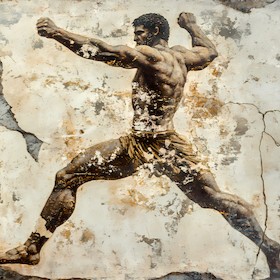El concepto paulino del cuerpo agonístico
Palabras clave:
cuerpo, agón, tragedia, paleocristianismo, paulinoContenido principal del artículo
En el presente artículo recuperamos la longeva tradición del agón, del combate y la competición, griego en tanto que vehículo idóneo para formular una teoría del cuerpo que, a diferencia del moralismo helenístico y parte del pensamiento del Segundo Templo, a un tiempo recupera, reinterpreta y reemplaza la construcción agonística del cuerpo en la tradición clásica. Defendemos que el corpus paulino trasciende el esquema clásico del protagonista y el antagonista para formar una teoría relacional del cuerpo agonista en que cuerpo y alma espejan el modelo relacional de las personas divinas.
Aristóteles. [Poet]. (1985). Ética nicomáquea (2ª edición) (J. Pallí, Trad.). Gredos.
Aristóteles. [Et]. (2011). Poética (T. Martínez y L. Rodríguez, Trads.). Gredos.
Belfiore, E. (1983). Aristotle’s Concept of Praxis in The Poetics. The Classical Journal, 79(2), 110-124.
Best, E. (1955). One Body in Christ. A Study in the Relationship of the Church to Christ in the Epistles of the Apostle Paul. S.P.C.K.
Epicteto. (1995 [50-135 d.C.]). Manual, fragmentos (P. Ortiz, Trad.). Gredos.
Fetherolf, C. (2010). The Body for a Temple, a Temple for a Body: An Examination of Bodily Metaphors in 1 Corinthians. Proceedings & Midwest Society of Biblical Literature, 30, 88-106.
Grassmick, J. (2000). The Old Man and the New Man: A Study in Pauline Theology. University of Glasgow [Tesis doctoral, Universidad de Glasgow]. Enlighten Theses. https://theses.gla.ac.uk/id/eprint/978
Gupta, N. K. (2010). Which “Body” Is a Temple (1 Corinthians 6:19)? Paul beyond the Individual/Communal Divide. The Catholic Biblical Quarterly, 72(3), 518-536.
Homero. [Od]. (1982). Odisea (2ª edición) (J. M. Pabón, Trad.). Gredos.
Homero. [Il]. (1991). Ilíada (E. Crespo, Trad.). Gredos.
Iglesia Católica. (1997). Catecismo de la Iglesia Católica. https://www.vatican.va/archive/catechism_sp/index_sp.html
Jaeger, W. (1965). Cristianismo primitivo y paideia griega. Fondo de Cultura Económica.
Jaeger, W. (1996). Paideia: los ideales de la cultura griega, Libros I-IV (J. Xirau y W. Roges, Trads.). Fondo de Cultura Económica.
Käsemann, E. (1933). Leib und Leib Christi, eine Untersuchung zur paulinischen Begrifflichkeit. Tübingen: J. C. B. Mohr (Paul Siebeck).
La Santa Biblia. (1953). Sociedades Bíblicas Unidas.
Lookadoo, J. (2022). The Corinthian Body: A Post-Pauline Somatic Metaphor in its Ancient Contexts. Korea Presbyterian Journal of Theology, 54(4), 33-59. https://doi.org/10.15757/kpjt.2022.54.4.002 DOI: https://doi.org/10.15757/kpjt.2022.54.4.002
Marco Aurelio. (1977). Meditaciones (4ª edición) (R. Bach, Trad.). Gredos.
Martin, D. B. (1995). The Corinthian Body. Yale University Press.
O’Reilly, M. (2020). Paul and the Resurrected Body: Social Identity and Ethical Practice. Society of Biblical Literature. https://doi.org/10.2307/j.ctvz7k30x DOI: https://doi.org/10.2307/j.ctvz7k30x
Parlebas, P. (1999). Jeux, sports et sociétés: lexique de praxeologie motrice. INSEP-Éditions. https://doi.org/10.4000/books.insep.1067 DOI: https://doi.org/10.4000/books.insep.1067
Pfitzner, V. C. (1967). Paul and the Agon Motif. Traditional Athletic Imagery in the Pauline Literature. Brill. https://doi.org/10.1163/9789004265936 DOI: https://doi.org/10.1163/9789004265936
Píndaro. [Ods.]. (1984). Odas y fragmentos (A. Ortega, Trad.). Gredos.
Platón. (1983). Diálogos II (J. Calonge, E. Acosta, F. J. Olivieri, y J. L. Calvo, Trads.). Gredos.
Platón. (1988). Diálogos III (C. García, M. Martínez, y E. Lledó, Trads.). Gredos.
Roberts, A., & Donaldson, J. (Eds.). (1885). The Ante-Nicene Fathers: Translations of the writings of the Fathers down to A.D. 325 (Vol. 2). Christian Literature Company.
Robinson, J. A. T. (1952). The Body. A Study in Pauline Theology. SCM Press.
Von Dem, M. A. (2019). La distinción aristotélica entre enérgeia y kínesis comprendida de modo intensional. Mutatis Mutandis. Revista Internacional de Filosofía, 1(13), 29–41. https://doi.org/10.69967/07194773.v1i13.179 DOI: https://doi.org/10.69967/07194773.v1i13.179
Downloads

Esta obra está bajo una licencia internacional Creative Commons Atribución-NoComercial-CompartirIgual 4.0.
De acuerdo con nuestra política (Licencia Creative Commons CC BY-NC-SA 4.0) los artículos presentados y sometidos al proceso editorial en la revista Praxis Filosófica no tienen costo alguno para sus autores ni retribuciones económicas para la revista. El artículo de carácter inédito, producto de investigación o de algún proyecto que se presente a Praxis Filosófica, no podrá estar sometido a otro proceso de publicación durante el proceso que se lleve en nuestra revista.

